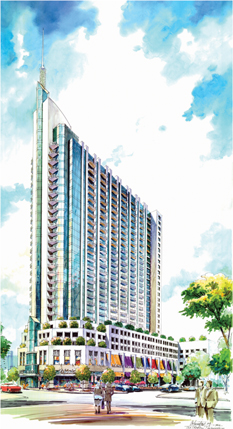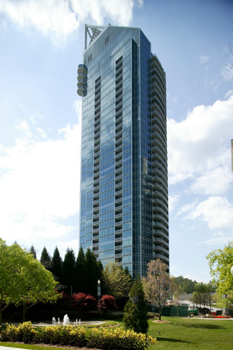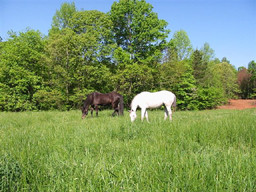 |
 |
 Oct/Nov 2004
Oct/Nov 2004
Hot Property
Hotlanta Housing Market Sizzles
by Jill C. Cox
 |
| Atlanta's majestic skyline. Photo courtesy of GDITT. |
Metro Atlanta's residents and visitors can't help but notice the plethora of developments under construction and see announcements for yet more communities to come. And as fast as they are built, these new residences are selling. In fact, Atlanta is the number one city in the nation for its quantity of new home closings. "It has been so for the past five years, and it will be again this year," says Steve Palm, president of Smart Numbers, an independent, Atlanta-based company that provides residential real estate information and analysis. "South Fulton alone--which only contains Atlanta's southern city limits--has had an increase of 444 percent in the last five years."
So what is fueling the housing boom in Atlanta? "People come because of jobs," says Dac Carver, who specializes in marketing and relocation services for Metro Brokers/GMAC Real Estate. "In the late '90s, Atlanta...led the nation in terms of job growth. We're talking about 80,000 jobs a year in the state, according to statistics."
The Metro Atlanta Chamber of Commerce concurs, predicting this growth will continue with an additional 2.3 million people and 1.7 million jobs projected over the next 25 years. "Growth specifically in outlying counties is due to cheaper land and home-value," says Carver.
Growth by County
A staggering 28 counties are included in the geographical area of Metro Atlanta, according to the U.S. Office of Management & Budget. Such a large, defined area for Atlanta is only proof of its urban sprawl.
Gwinnett County, just up Interstate 85 to the northeast, led the metro area last year in single-family residential growth with over 9,000 new building permits. Approximately one out of every five new homes is built there. Fulton, Cobb, DeKalb and Henry counties followed Gwinnett's growth, respectively. (Source: U.S. Census Bu
reau, 2004).
Douglas County had the highest percentage increase (36%) in new home sales over last year, meaning they were the fastest growing in terms of new home sales. This was followed by Rockdale (34%), Forsyth (18%), Cherokee (16%) and Clayton (14%) counties. (Source: Smart Numbers). New construction in the neighboring counties is credited to the limited amount of land left in town. Paulding County to the west and Newton County to the east, for example, are viewed by many in the housing industry as outgrowths of Cobb and Rockdale counties, respectively. "There's just little to no land left to develop and build in those areas," Carver says.
Moreover, the number of building permits for single-family units increased by nearly 10 percent from 2002-2003, while the number of multi-family permits declined by 30 percent. This trend shows that people who are moving into communities in the outlying counties want land for their kids and families, and they can get it for sometimes a third of the price for what it might cost to buy closer to their jobs. "You can get so much house for the money," Carver says about developments outside the perimeter, the area outside of Interstate 285, which encircles the city.
Even so, metro Atlanta ranked fourth as the most affordable metro area in the nation with a median household value of $135,000, according to the U.S. Census Bureau 2000 Housing Survey. Fulton County, which contains the city of Atlanta, is the state's largest and most populous. Last year, it had over 5,700 new home sales, which included a mix of new single-family dwellings in underutilized or redeveloped areas, as well as new condo, townhouse and loft construction--not to mention the trendy, new live/work/play developments. Of course, this excludes the number of single-family home closings in historic and well-established neighborhoods, which thirty-something's seem eager to purchase and remodel with modern amenities.
Neighborhood Trends
Smyrna, a city that was originally built as an outlying suburb with plenty of land, is just a 15-minute drive north up I-75 from downtown Atlanta. With a population of 44,000 scattered across 16 square miles, this area began as a religious campground "hence the name, 'Smyrna,' which is from the Book of Revelations in the Holy Bible," says Jennifer Bennett, community relations director for the City of Smyrna. Now, a lot more spiritual and cultural diversity is found--more than 30 different languages are spoken at Campbell High School, city officials boast. Bennett says dialogue is currently underway about the "redevelopment of underutilized properties, which are few." Because land is scarce, reclaiming underutilized properties--or lots not currently used for residential, commercial or recreation uses--may be a vital source of "new" land available to developers. This new development plus the revitalization of downtown Smyrna and a live/work community called The Village Green, has people flocking to the suburb, raising the median housing value to nearly $92,000 with new housing prices ranging from $375,000 to $1.4 million.
Closer to downtown Atlanta, gentrification--the restoration and upgrading of deteriorated urban property--spurred development of lofts, townhouses and newly remodeled homes in historic neighborhoods such as Castleberry Hill, located just south of Philips Arena, the Georgia Dome and Georgia World Congress Center. The area was once a railroad-related business center and is now recognized by the National Register of Historic Places as the area that contains the largest and most concentrated remnant of railroad buildings in Atlanta. Today, a few artists inhabit some of the area's old warehouse buildings, and loft living is quite popular here. "I used to live in a 350 unit high-rise condo building and I decided I wanted something more unique," says Walter Patterson, an area loft resident. "I still wanted to be downtown and close to work and a bike path, but I wanted more square footage and fewer units for a more individualized feel--a converted loft was exactly what I was looking for," says Patterson.
In the southwest section of the city, West End, named after the popular theater district in London, is Atlanta's oldest neighborhood. Bordered by Interstate 20 to the north and White Street to the south, this historic district was once home to Joel Chandler Harris, author of the Uncle Remus Tales, and Pearl Cleage, whose recent novel, Some Things I Never Thought I'd Do, takes place in West End. A tour through this area reveals a rich architectural mix of bungalow and Victorian-style homes, which are now home to upper class African-Americans and their families. The convenience to public transportation and the surrounding affluent Atlanta University Center including Atlanta Clark University, Morehouse College, Spelman College and the Interdenominational Theological Center, have made it a booming part of downtown.
City living with an "established neighborhood feel" is key to the appeal of Oakhurst, a community located in the southwest section of Decatur, between Atlanta and Stone Mountain. With its blend of coffee houses, galleries and restaurants featuring various ethnic foods, mixed in with the area's beautiful old oak trees--many ranging from 50 to 100 years old--and traditional-style homes, Oakhurst epitomizes diverse city living at its best. "It's an old neighborhood that has walking capabilities that many Atlanta neighborhoods do not have," says Maria Vinces, an Oakhurst resident for six years. "Oakhurst is perfect for the newly-married or couples with young children who have outgrown the high-rise condo or open loft floor plans, but still want to be close to things," says Vinces. Turn-of-the-century ranch-style homes with front porches and craft-style bungalows line many of the streets. Even new construction in the area emulates this style in order to blend in with its surroundings.
If you're not sure about city living and willing to commute for more property, Serenbe, is located 32 miles southwest of Atlanta between Fulton and Coweta counties and is popular with homebuyers because of its many offerings. For as low as $250,000 and up to $500,000, you can buy a live-work unit (a home located above a commercial and/or retail space), cottage or townhome on this 900-acre property, 70 percent of which is allotted for green space. What's especially unique about Serenbe is that it offers organic farms, an organic food market and even a horse stable for residents to enjoy.
Hot Properties
How many times have you seen the American dream depicted with a house and a white picket fence? Well nowadays, that image has transformed into a variety of ideals and definitions. These days, the sale of high-rise condominiums, lofts and townhomes are just as common as traditional single-family homes.
 |
| Spire in Midtown is set for completion in September 2005. |
"The wave of the future seems to be to get to the point where there's no need to drive," says Betty Harbourt, senior vice president of Coldwell Banker Atlanta. Harbourt says the more desirable areas to live and not drive are Midtown, Buckhead and downtown Atlanta. "Single-family homes tend to be more expensive in these areas," she says, "and since people want to live closer to work and play, multi-family dwellings are the most popular option." Developers such as the Novare Group, Wood Partners and Beazer are delivering.
The Novare Group Inc., for example, has partnered with Wood Partners to create and develop condominiums where 10-foot ceilings, floor-to-ceiling windows and granite countertops are standard in every unit--all with a starting price for as little as $130,000 for a one-bedroom condo. This means amenities that traditionally have been considered upgrades in Atlanta are now expected by homebuyers.
Therefore, today's developers must deliver a better product at attractive prices. Given the response to several new communities, they've hit on the right combination. For example, Novare Group built the complex Metropolis in Midtown and is now building and completing units in Eclipse just north in Buckhead. Amazingly, the units in both developments sold quickly, long before construction was complete.
"It's the first real alternative to live where they want to live," says John Hogan of Novare Group. "They" refers to the demographic of 25- to 35-year-olds who are educated professionals. He says that many, by age 25, are more likely to buy than rent, but that they may not have a large cash flow. Moderately priced complexes like his appeal to their wish to be near entertainment venues where they can meet people. "These places are usually not a place for children or young families. About 90 percent of our buyers are single," Hogan says.
Novare Group and Wood Partners hope the trend of being sold out before construction is complete continues with their new 29-floor high-rise, Spire, to be located in Midtown. Spire is similar to Metropolis and Eclipse in terms of its offerings and, although selling begins in November, the construction won't be completed until September of 2005.
Plans are also underway for TWELVE Hotel and Residences, a project that's said to be the first of its kind in Atlanta. The project will open at Atlantic Station in fall 2005, and will feature 404 luxury condos atop a boutique-styled, all-suite hotel. It will provide homeowners with amenities normally associated with a hotel, such as concierge service, room service and boutique shops. In addition, Novare Group will also build TWELVE at Centennial Hill, which will include two 32-story towers, a hotel and condominiums, all within walking distance of Centennial Olympic Park and the new Georgia Aquarium. The groundbreaking is expected to be in late December or early January.
Atlantic Station is a live/work/play community, accessible by the new 17th Street Bridge off the Interstate 75/85 Connector in Midtown. It boasts 138 acres of land that is being developed into 3,000 to 5,000 residential units--for sale and for rent--and 1.5 million square feet of retail, including the Southeast's first IKEA contemporary furniture store and SouthTrust Bank. Entertainment space includes restaurants, a 16-screen movie theater, plus 1,000 hotel rooms in at least three hotels.
The Art Foundry within the complex is a fast-selling condo choice with units beginning at $160,000. A simple walk across the pedestrian bridge to a park complete with benches, fountains and art--artifacts from its previous Atlantic Steel Mill days--should fill any void of suburb living. The park's surrounding sidewalk and bike path gets glowing reports from cyclists.
Atlantic Station also offers single-family attached units like the Beazer-built models, starting in the low $200,000-range. A tour inside shows well-planned amenities, such as an upstairs laundry room and large windows in every room on the same side as the skyline view. While each unit only has two bedrooms, they're each large enough to make either one the possible master
 |
| The Buckhead Grand |
Another example of these live-mix-play developments, Glenwood Park, is located at Interstate 20 and Glenwood Avenue, about two miles east of downtown Atlanta. Walter Brown, vice president of Green Street Properties, the property's developer, is proud of his environmentally-sound community that offers as much attention to cyclists as it does businesses. The builders recycled many of their materials and are hoping its pedestrian-friendly design will translate into fewer drivers.
A walk through Glenwood Park reveals single-family homes--some with double porches, quaint courtyards and sidewalks throughout the community--as well as three-story townhomes--even one with a rooftop patio, parallel parking and a central park. By the time the entire 28-acre development is completed in 2006, there will be 60 single-family houses, 100 to 130 townhouses, 200 multi-family residencies and 50,000 to 70,000 square feet of shops and office space. It's definitely a village unto itself without much reason to venture out. Prices and sizes here vary, depending on the size dwelling. A typical single-family detached home sells in the mid-$400,000 range.
Another popular choice is the Buckhead Grand, located within walking distance of Phipps Plaza and the Ritz-Carlton in Buckhead. Upon arrival, the valet and doorman greet residents long before a concierge is seen, thus giving the feeling that one has stepped into the Waldorf Astoria instead of a residential complex. And a look at the one-, two- and three-bedroom and penthouse condos, solidifies the fact that it is a divine and ritzy complex. Extra touches can be found in the smallest details, such as having the residents' choices of magazines scattered throughout the common areas. The price range here is from the low $190,000s for about 900 square feet to more than $1 million for the penthouse views.
A new townhome development, M West is located just west of Midtown in the thriving Northwest Corridor (from Interstate 75 in Cobb County to downtown Atlanta). Touted as a first-of-its-kind project in Atlanta because of its plan to emulate a European hill town with contemporary-style townhomes, this development starts in the high $100,000s, with most of the homes available for less than $250,000. The first homes won't be completed until later this winter.
Lofts, with open floor plans, exposed ceilings and piping are also popular with many who live downtown. If new construction is preferred, The Block Lofts at Poncey Highlands offer the "loft look" with new amenities. The condominium floor plans feature one and two bedroom flats as well as two-story lofts with mezzanines. These units include environmentally responsible bamboo hardwood floors, oversized windows, 10-foot ceilings and stainless steel appliances. The development itself includes 69 loft condos and 244 apartment units, along with a courtyard and junior Olympic size lap pool, fitness center, clubroom, private cyber cafe with computer access, and an outdoor fireplace and barbeque area. Prices for the lofts range from $150,000 to $250,000.
Of course, you still can opt to buy the traditional, single-family detached home.
The fastest-growing areas for many high-end homebuyers are in Fayette and Paulding counties, while South Fulton and Coweta counties are popular choices for low-end prices. These counties are expanding rapidly because of the available land there. Just as multi-unit dwellers expect certain features in their living space, high-end single-family detached homebuyers expect fireplaces with built-ins above them, high ceilings, granite countertops, master bedrooms on the main floor, and, in some cases, guest suites with full baths as well as laundry rooms upstairs.
 |
| The Estates at E-QUEST features horse farms. |
Lassiter Walk, a new East Cobb subdivision, offers all these features and more starting at $700,000. What's unique about this property, however, says Lee McGregor, an onsite sales agent, is that each home has five bedrooms, with a master on the main and, in many cases, on the second floor, too, with four and one-half to five and one-half baths. Each home also features a rear-entry garage, and all are individually gated and equipped with a privacy fence in the backyard. "It's a new dimension into suburbia," McGregor says. "The homes here are not all carbon copies, either."
While communities offering common areas with a pool and tennis courts still exist, the increasingly popular choice is the equestrian option. The Estates at E-QUEST in Cherokee County, for example, is pre-selling at an amazing rate, Harbourt says. It features horse farms and a 12-mile riding trail. After your ride is over, you can return to your home without ever leaving your subdivision.
Convenience, rather than recreational amenities or location, seems to be important to everyone in our fast-paced society. So, no matter your version of the American dream, if you want to turn it into reality, consider your lifestyle, priorities and, of course, budget to narrow down the many housing options popping up in and around Metro Atlanta.
|
 |
  |
 |